Time for another virtual field trip on the Geologist’s Grand Tour of the United Kingdom: the most famous outcrop in the world. Today, we visit Siccar Point, Scotland.
You’ve probably already seen photos of this place – they usually look something like this:

To those who aren’t familiar, here’s what going on:
There are two sets of strata here – and the contact between them is an ancient erosional surface. It’s an angular unconformity, the very first one identified — anywhere, ever.
When James Hutton brought his friend John Playfair here in 1788, he explained the significance of such a structure: It implied that (1) Silurian graywackes and shales were deposited horizontally, (2) they were subsequently folded and tilted to more or less vertical orientations, (3) a period of erosion commenced, chewing away at their upper ends, (4) erosion ceased and deposition resumed, but now the environment of deposition had totally changed – instead of deep marine strata, oxidized fluvial redbeds were laid down (the Old Red Sandstone) — again in an original horizontal orientation, then (5) these too were tilted to their present angle gently dipping off to the left of the frame, and (6) modern erosion went to work on the whole mess, carving it up into the three-dimensionally complex exposure we find today.
Hutton pointed out that this whole sequence would probably take a little while. Playfair recounted the sense of temporal vertigo Hutton had induced in him: “The mind seemed to grow giddy by looking so far into the abyss of time.”
Siccar Point, then, was the place where the immense depth of geologic time was first realized. It was the first time it was felt!
I got into the spirit of the place by putting myself in the place of (A) the turbidites, (B) the ancient erosional surface, and (C) the red beds:

But there’s much more to Siccar Point than just this one oft-photographed scene.
Just walking in to the site is a treat – looking both ways along the coast, you can see the relevant units – with Old Red Sandstone dominating to the northwest, and Silurian turbidites to the southeast:
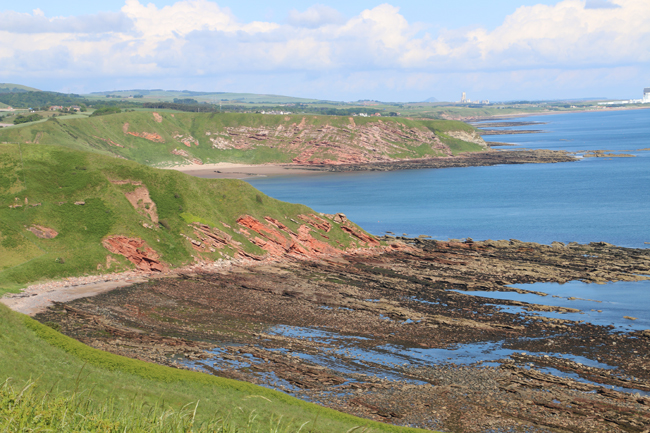
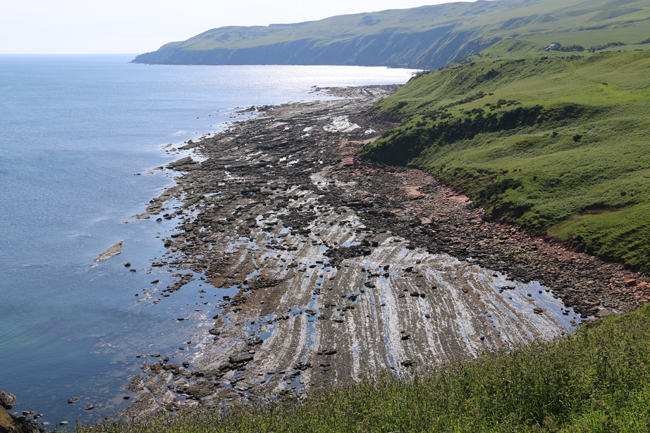
The first view of Siccar Point itself comes from a great height:
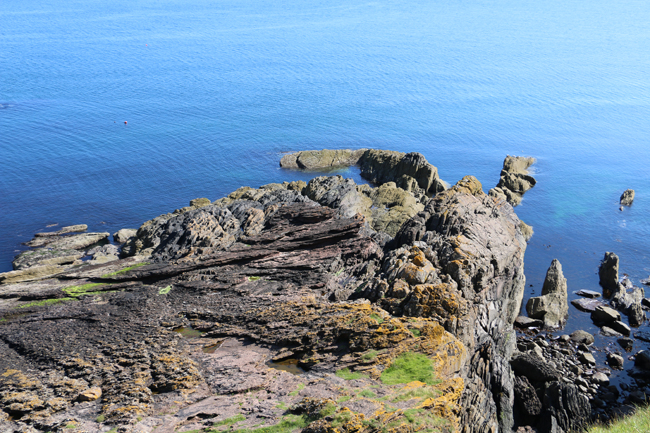
I paused there to capture the view on GigaPan (see the resulting image later in this blog post):
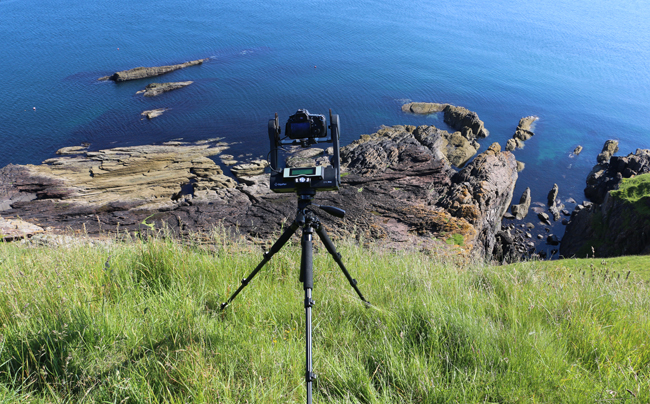
Then, we descended. As you can see, we had awesome weather – but this slope was so steep, next to a knee/chest level strand of rusty barbed wire, that I shudder to imagine descending it on a rainy day:

Because the modern waves have sculpted Siccar Point into a complex shape, there are a dozen ways to view the unconformity, dipping down below it in places (entering the upended Silurian) and popping back up again, like a time-traveling gopher (daylighting into the Devonian).

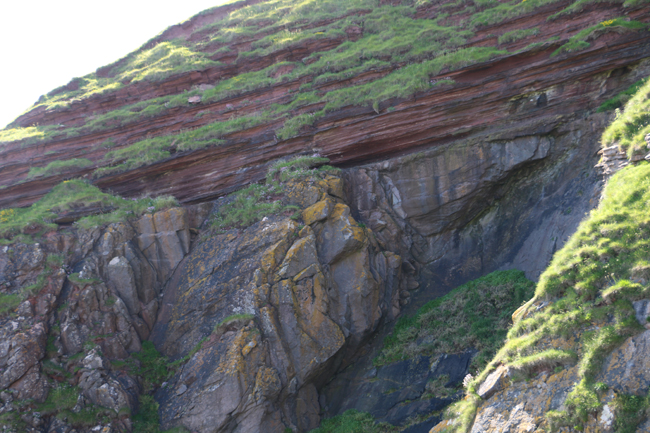
The unconformity surface is laced with boulders and cobbles – the rubble of the eroded Silurian graywackes that became a basal conglomerate for the overlying red beds.
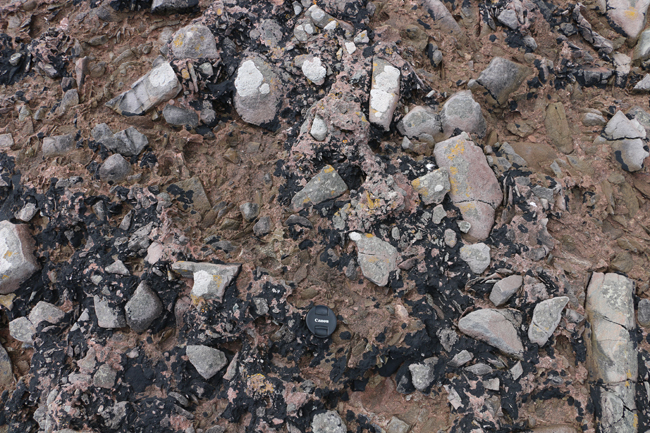
There is some tafoni to be seen, too – always a treat!
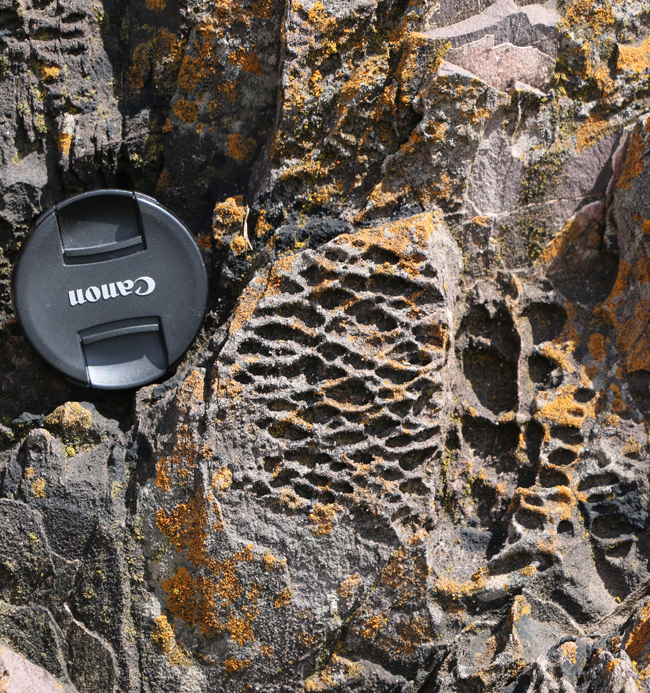
Another thing you can see in the previous image is orangey-yellow lichen, of which there is quite a lot at Siccar Point. I was surprised at this – even though the two rock units here are very distinct in color, both actually appear similar because of all the lichen encrusting them!
In fact, there is very little “clean” rock exposed here – if it’s too high up, it’s covered with lichen, and if it’s too low in elevation, the tides bring nutritious waters up twice daily, meaning it’s prime for colonization by barnacles. In between, you might find some decent views into fresh rock. But don’t hammer! This is as close to sacred ground as geologists get! Here’s a view showing the vertical zonation:
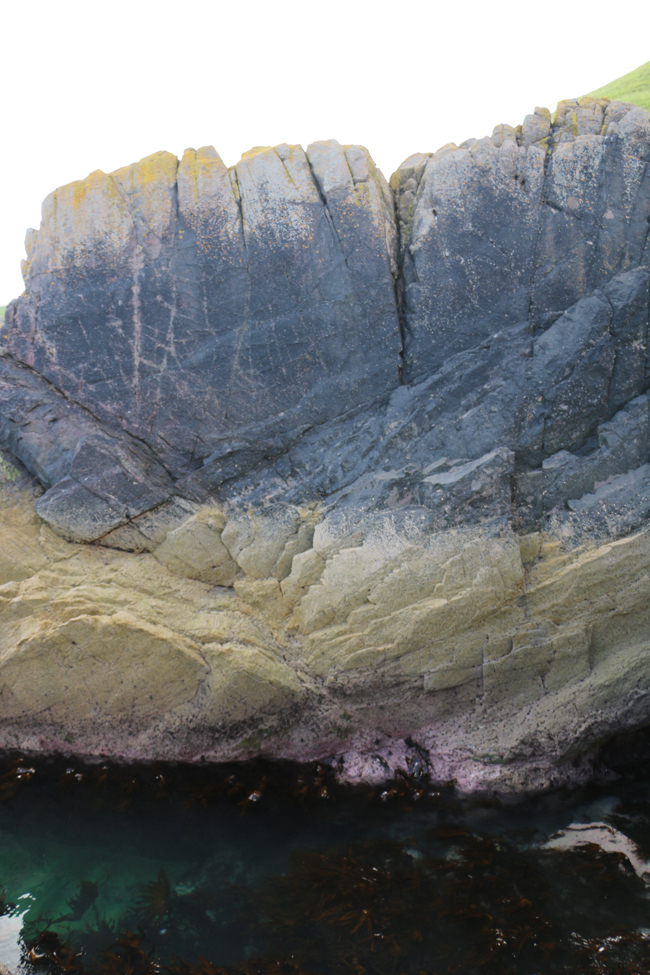
In the thin zone where the rocks are clean, you can see features such as graded bedding. Here, a single turbidite is imaged, with the coarse base on the left, and then fining (younging) toward the right, where the lens cap lies atop some thin laminations:
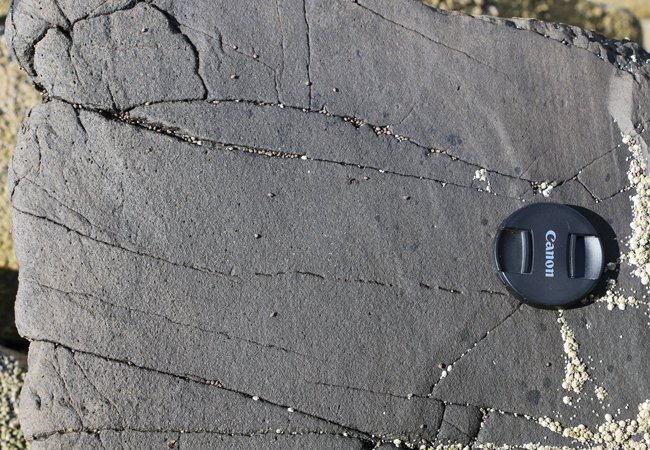
Here’s another, with the opposite geopetal implication:
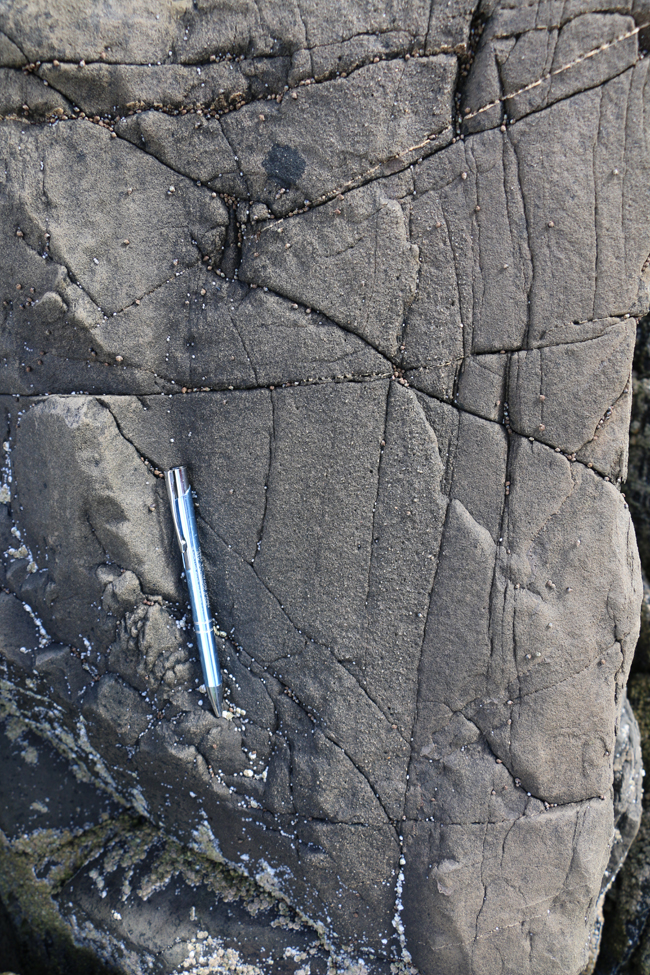
It gave me a little frisson of satisfaction to walk out to the hinge of the plunging syncline I featured here as a Friday fold back in February:
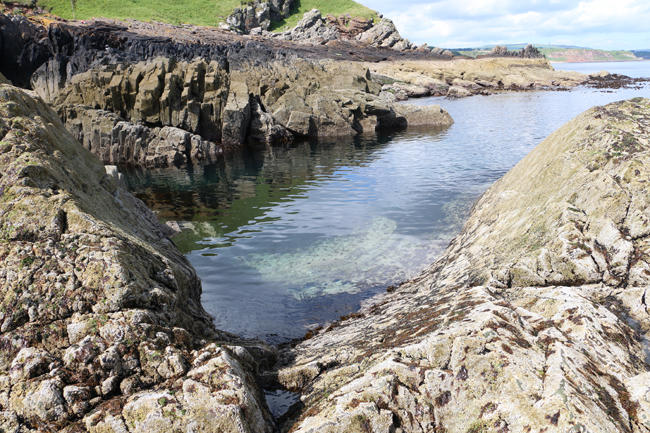
Here’s a view of the same fold, from the other side of that little bight — You can see the nested “>>” shape of the barnacle-encrusted turbidite layers, in this case plunging to the lower-left:

Fractures in the upturned Silurian graywackes give the clean rocks a tesselated appearance:
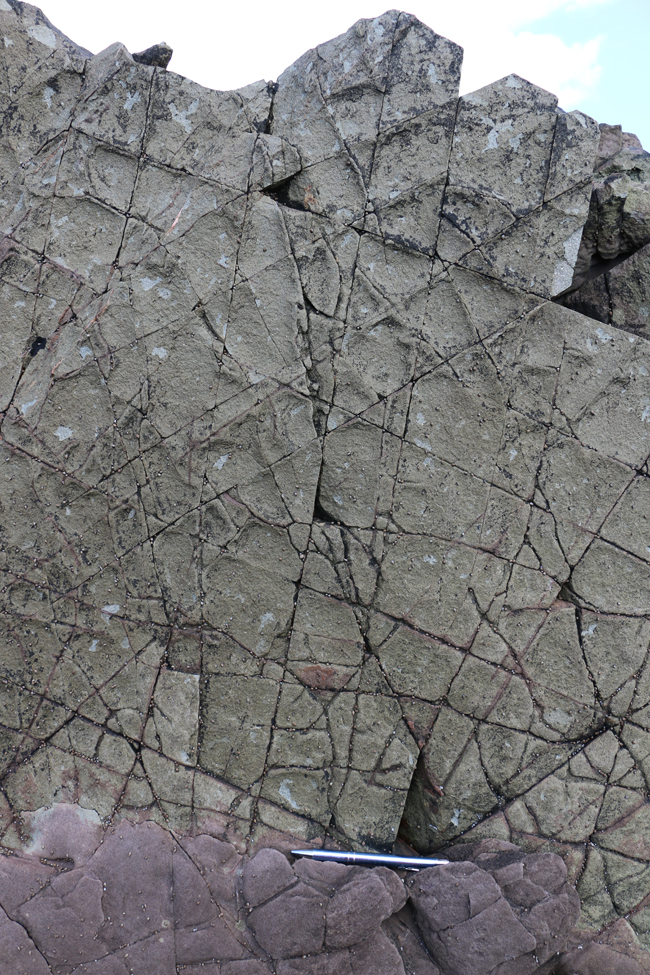
And not all the fractures are joints – some are faults!

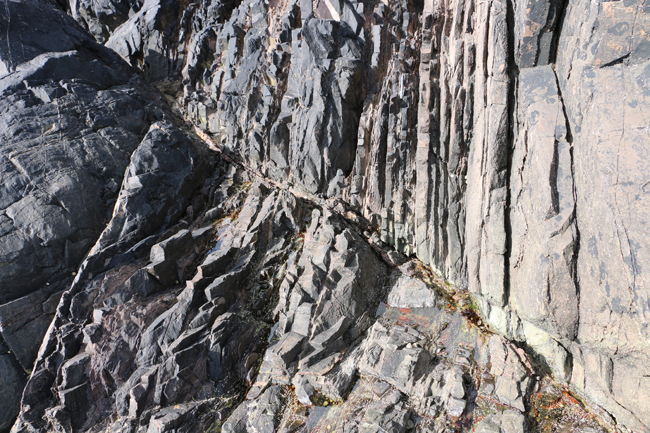
So there’s a lot of fun stuff to contemplate here. To provide a user-directed facsimile of a real-life visit to Siccar Point, I gathered some visuals for you. Here are four GigaPans of the site:
Link GigaPan by Callan Bentley
Link GigaPan by Callan Bentley
Link GigaPan by Callan Bentley
Link GigaPan by Callan Bentley
Next up, here are four Theta 360 spherical photos:
Planet Hutton! Siccar Point unconformity, Scotland #theta360 – Spherical Image – RICOH THETA
Siccar Point unconformity, Scotland #theta360 – Spherical Image – RICOH THETA
Siccar Point unconformity, Scotland #theta360 – Spherical Image – RICOH THETA
And then —our coup de grâce— we have two awesome 3D models of the unconformity surface – one zoomed out a bit:
Photoscan model by Marissa Dudek
…And closer in on a key area:
Photoscan model by Marissa Dudek
Honestly, I think these two 3D models (photo sets by me, model construction in Agisoft Photoscan by my student Marissa), are one of the most important things I have accomplished so far on this trip. Because Siccar Point is a wave-blasted headland, the outcrop surface is a complicated shape, and that makes photographing it complex. Essentially, there’s one view that easily captures the relationship between the two rock units, and that’s the one that everyone takes – the view that started off this post. But Siccar Point is bigger than that one view, and I think it takes something like these 3D models to convey a real understanding of the complicated geometry of the place – an important step for inducing the “giddyness” that John Playfair and James Hutton enjoyed while visiting the site.
I feel extraordinarily fortunate to have been able to visit Siccar Point with my family on such a beautiful day. I hope that you are able to access some of the giddy joy I felt there with this virtual field trip!
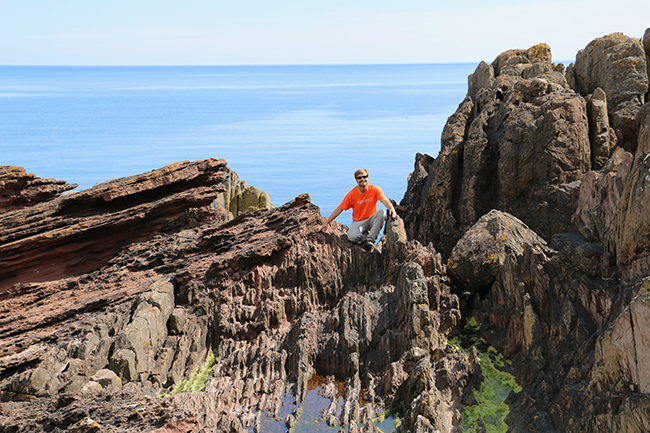

Just amazing. Fantastic job putting that all together.